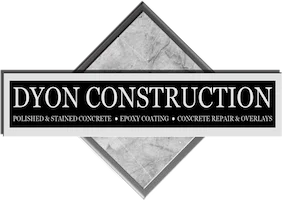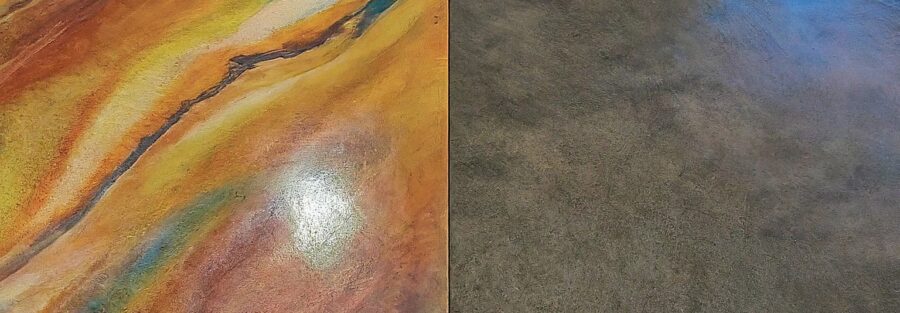Decorative concrete has surged in popularity over the past few decades, offering homeowners, architects, and designers a versatile medium for creating elegant, durable surfaces. Two of the most sought-after treatments are stained and polished concrete. Both of these finishes transform the typically mundane, utilitarian nature of concrete into something refined and visually appealing. Whether used in residential homes or sprawling commercial spaces, stained and polished concrete provide options that are as functional as they are beautiful. Yet, while these two methods share some similarities, they deliver distinct results in terms of aesthetics, durability, and maintenance. Understanding these differences is crucial for making the right choice for any given project.
Stained Concrete Overview
Stained concrete offers a rich, dynamic aesthetic that can drastically change the appearance of an ordinary concrete surface. The process of staining involves applying a specialized chemical or water-based solution to the surface, which reacts with the concrete to create a range of colors and patterns. There are two primary types of stains: acid-based and water-based.
Acid-based stains create a more natural, variegated look, often resembling the hues of stone, marble, or even leather. These stains penetrate the concrete surface and react with the minerals inside, resulting in rich, earthy tones like browns, greens, and terra cottas. Because acid stains are reactive, the results can be somewhat unpredictable, giving each project a unique character with swirls, mottling, and variations that add depth and texture.
On the other hand, water-based stains provide a wider range of color options, including bright, vibrant hues that can’t be achieved with acid stains. These stains don’t rely on a chemical reaction with the concrete, so the application is more uniform and predictable. However, water-based stains do not penetrate the concrete as deeply as acid-based alternatives, making them slightly less durable over time. Despite this, they are often favored for projects requiring specific or non-traditional color palettes.
Beyond the aesthetic options, stained concrete has other notable benefits. It is relatively affordable compared to other decorative flooring options, and the application process is relatively straightforward, involving cleaning, applying the stain, and sealing the surface to protect it from wear. Stained concrete is also extremely customizable, allowing for patterns, logos, or even intricate designs to be embedded within the floor.
Because stained concrete doesn’t create a film on the surface but instead penetrates the substrate, it is resistant to peeling, chipping, or fading under regular use. This makes it a durable choice for spaces that see significant foot traffic, like restaurants, hotels, or even large open areas in homes such as living rooms or patios.
Polished Concrete Overview
Polished concrete, by contrast, is a treatment that focuses on bringing out the inherent beauty of concrete itself through a meticulous process of grinding, honing, and polishing the surface to achieve a high-gloss finish. The end result is sleek, contemporary, and highly reflective—a look that has become synonymous with modern minimalism and industrial chic.
The process of polishing concrete begins by grinding down the surface with heavy-duty machines using progressively finer abrasives, which smooth the surface to varying degrees of gloss. Polishing can be done to create a satin finish or a mirror-like reflective sheen, depending on the desired outcome. During this process, densifiers are often applied to the surface, which penetrate the concrete and harden it, making the floor even more resistant to wear and tear.
Polished concrete floors are notable for their mirror-like appearance, which reflects light and can help brighten indoor spaces. This reflective quality not only enhances the visual appeal of polished concrete but can also contribute to energy savings in large spaces, as the reflective surface requires less artificial lighting.
A unique aspect of polished concrete is its ability to reveal the aggregate beneath the surface, which can create a terrazzo-like effect. The level of aggregate exposure can be controlled during the grinding process, offering yet another dimension of customization for the floor’s appearance. While stained concrete relies on external colors and patterns, polished concrete derives its beauty from the concrete itself—enhanced by the polishing process.
Durability is another key feature of polished concrete. Once properly sealed and polished, the surface is resistant to scratching, staining, and water damage. Polished concrete is particularly suitable for high-traffic environments, such as retail spaces, warehouses, and office buildings. Its seamless surface is also hypoallergenic, making it a good choice for areas where cleanliness is a priority, such as hospitals, schools, and residential homes with pets or children.
Pros and Cons of Each
When it comes to choosing between stained and polished concrete, understanding the pros and cons of each is essential, particularly in terms of durability, aesthetic appeal, and maintenance.
In terms of durability, both stained and polished concrete are robust options, but they each have unique advantages. Stained concrete, especially when sealed properly, is highly resistant to wear and tear, making it suitable for outdoor applications like patios, pool decks, or driveways. Acid-stained concrete, in particular, is resilient against UV light, meaning it won’t fade over time, even with prolonged sun exposure.
Polished concrete, however, is often considered the more durable of the two for indoor applications. The surface is incredibly hard and scratch-resistant, making it ideal for commercial spaces that experience constant foot traffic. Polished concrete also requires little in terms of maintenance beyond regular sweeping and occasional wet mopping, as the polished surface resists stains and does not require waxing or refinishing.
From an aesthetic perspective, stained concrete offers a much broader range of colors and patterns. Whether you’re looking for warm, natural tones or bold, vibrant hues, stained concrete provides more flexibility in terms of design. The unpredictable nature of acid-based stains creates a one-of-a-kind look, while water-based stains provide more control over the final appearance.
Polished concrete, on the other hand, excels in creating a sleek, modern look. The reflective surface of polished concrete is visually striking, and its ability to highlight the natural beauty of the aggregate adds a level of sophistication to any space. However, the color options for polished concrete are more limited compared to stained concrete, and additional color treatments may be necessary if specific hues are desired.
Maintenance is another important factor to consider. Stained concrete requires regular resealing to maintain its appearance and protect it from staining, especially in areas where it may be exposed to moisture or chemicals. The frequency of resealing depends on the level of traffic and exposure to the elements, but in general, stained concrete needs more upkeep compared to polished concrete.
Polished concrete, in contrast, is extremely low-maintenance. Its smooth, dense surface resists stains and spills, making it easy to clean with just water and a mild detergent. Polished concrete does not require sealing, waxing, or other treatments to maintain its glossy appearance, which reduces long-term maintenance costs.
Suitability for Different Environments is another critical consideration. Stained concrete’s versatility makes it suitable for both indoor and outdoor applications. Its ability to mimic natural materials like stone or wood makes it ideal for outdoor spaces such as patios, walkways, and pool decks, where it can blend seamlessly with the natural surroundings.
Polished concrete, by contrast, is best suited for indoor environments. Its high-gloss finish can become slippery when wet, making it less suitable for outdoor use, especially in areas that are frequently exposed to rain or snow. However, indoors, polished concrete shines—literally and figuratively. Its reflective surface brightens large spaces, making it an excellent choice for commercial and residential interiors alike.
Both stained and polished concrete offer unique advantages, making them popular choices for decorative flooring in residential and commercial spaces alike. Stained concrete provides a wide range of color options and design possibilities, making it an excellent choice for those looking for a customized, artistic finish. Its ability to withstand outdoor elements also makes it ideal for exterior applications.
Polished concrete, with its sleek, reflective surface and low-maintenance nature, is a perfect fit for modern, minimalist interiors. Its durability and resistance to wear make it ideal for high-traffic indoor environments where aesthetics and longevity are both priorities.
Ultimately, the decision between stained and polished concrete depends on the specific needs and vision of the space. For vibrant, varied aesthetics and outdoor applications, stained concrete is the clear winner. For a durable, modern look that stands the test of time indoors, polished concrete is the best choice.

